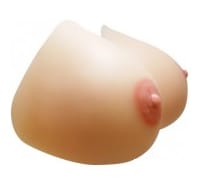 What material your breast forms will be made of will often be determined by your budget, the desired quality and realism and how they are to be used (daytime wear, sleeping, leisure or exercise etc). Most commercial breast forms are made of:
The majority are manufactured from silicone gel but scores of other materials are used to create home-made breast forms. What is the Price Range?Although silicone and latex breast forms are still the most expensive, over the last 10 years they have come down in price with the introduction of Chinese manufactures. Nowadays, vendors like GlamourBoutique.com offer affordable silicone breast forms from under $50 a pair, for example, which was unheard of ten years ago. Which Materials are the Best for Breast Forms?With the wide variety of materials used to make breast forms, which is the best and how does the different material used affect how real the forms are? Silicone Breast FormsThe most widely used of any breast form prostheses. How are silicone breast forms made? By pouring silicone gel into a mould lined with an outer PU (clear plastic) shell which protects the silicone gel and maintains the shape of the breast. Most crossdresser/transgender breast forms will have a darker, life-like areola and nipple set in the bottom of the mould first, with the lighter flesh silicone gel poured on top. Advantages of silicone breast forms: softer than anything else, most closely approximates flesh breasts in weight, touch, movement, droop and coloring. Disadvantages of silicone breast forms: Can be damaged by sharp edges, extreme heat or cold. More expensive than most other materials. Difficult to color-match unless you use the newer, more expensive specialist silicone breast forms like the Real Breast. Pals, Non-Silicone Breast Forms One of the alternative gel formulas to silicone is Pals, which is manufactured with a non-silicone, non-toxic gel. aged by sharp edges, extreme heat or cold. More expensive than most other materials. Difficult to color match unless using the newer more expensive specialist silicone breast forms like the Real Breast. Pals Breast FormsHow Pals breast forms are made: Although Pals come as a shaped breast form, they can be safely customized to your chest by trimming with a craft knife or even scissors. Advantages of Pals gel breast forms: Full five-year guarantee. Can’t be punctured, so much more durable than silicone. Unlike silicone forms, Pals are porous so they will absorb makeup and you can color them to your exact skin tone. Can be slept in safely. Disadvantages of Pals gel breast forms: Harder and heavier than silicone breast forms and so not as free-moving as silicone. No medical grade adhesive available to go braless. LATEX OR RUBBER BREAST FORMS: Latex or Rubber Breast Forms Traditionally, these have been a cheaper type of breast form. How latex/rubber breast forms are made: Latex breast forms are often filled with much cheaper foam rubber, so they are not a solid breast form. Today, however, there are some professional prosthetic-makers who use latex to make high-end, realistic breast forms and body suits for crossdressers and transgenders. Advantages of latex/rubber breast forms: Possible to find cheap breast forms and breast plates made with latex rubber on the outside. Disadvantages of latex/rubber breast forms: These breast forms are not solid and have a cheaper, much lighter filling material like foam. This means they cannot replicate the weight, touch or movement of a silicone breast form. Foam Breast FormsHow do Foam Breast Forms Work? Breast forms made of foam are primarily an affordable prosthesis that gives the very best approximation of shape of a real breast but none of the qualities of weight, droop, feel etc. Advantages of foam breast forms: Good, cheap alternative to silicone, giving a good shape that lasts. A great sleep breast form since they maintain their shape and cannot be damaged if pressure is placed on them whilst sleeping. Disadvantages of foam breast forms: Normally made from neutral-colored memory-type foam that is slightly stiffened to maintain shape. They can get dirty quickly as foam is absorbent and porous. Also, foam breast forms have none of the weight, droop or feel of a real breast so there is minimal movement with the body, making them look and feel a little unnatural. Home Made Breast FormsHome-made breast forms with gel forms inside balloons or food bags. Homemade breast forms with a gel base are great because they can approximate the weight, feel, droop and movement of a real breast at a fraction of the cost of a silicone breast form. You can use silicone from caulking guns and even the powder from diapers, which turns to silicone-like gel upon contact with water. This process can get messy though, so take appropriate measures. For in-depth instructions on how to make your own breast forms you can read our previous article ‘Breast Forms on a Budget – How to Make Your Own’ which explains the different methods and takes you through the process step-by-step. As you can see, breast forms can be made of many different materials but the more realistic ones are certainly the gel-based forms, whether commercial grade or home-made. Whatever your budget or intended use, there are many options open to you. The Glamour Boutique breast form selection covers many different materials, from a basic pair of silicone breast forms at under $30 a pair to a high-end, ultra-realistic looking breast form at over $750. The point is you have options and can even choose to make your own if you have the time and patience. |